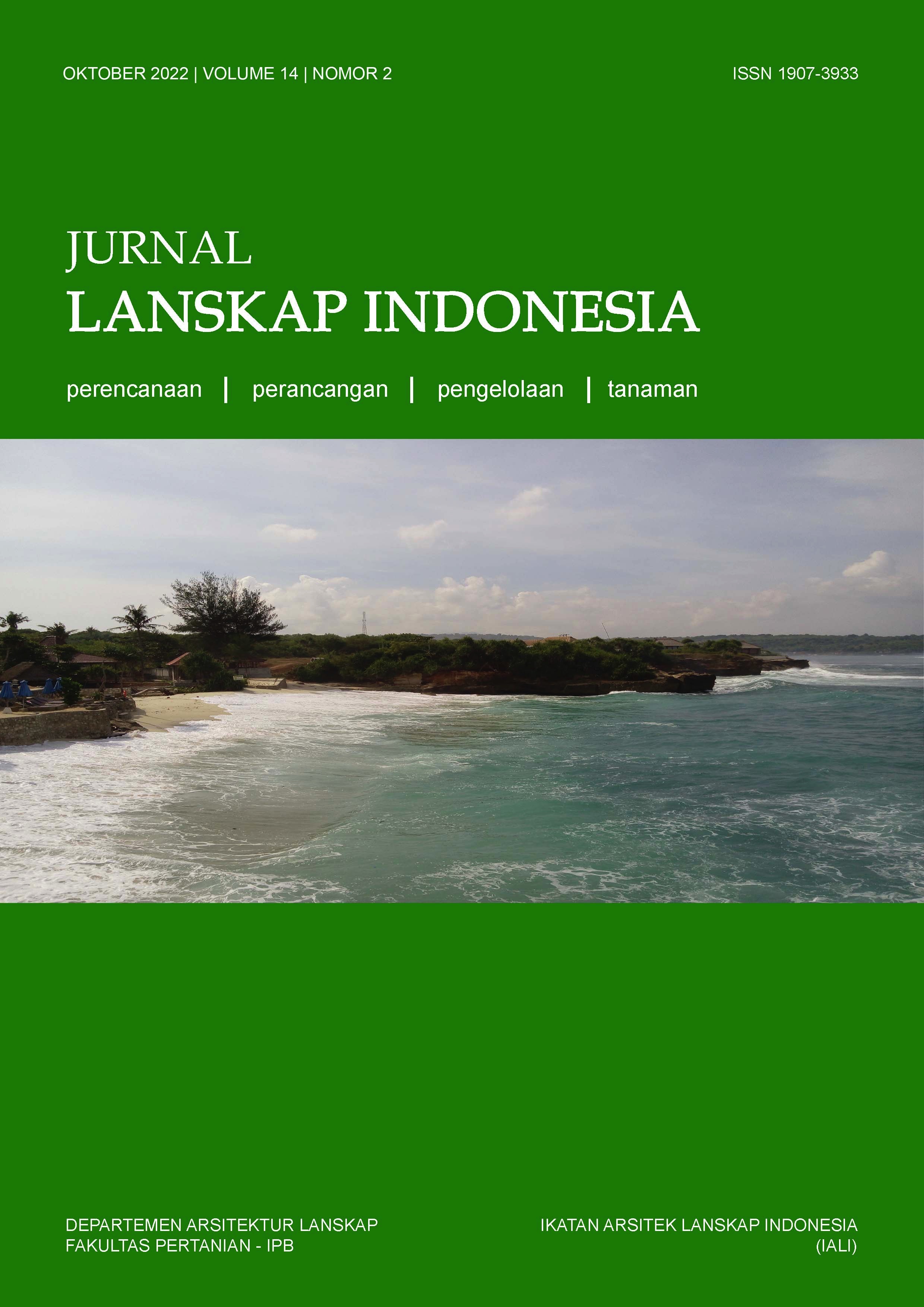A Study on the Potential Vulnerability of Debris Flow Hazard in Sukabumi Regency
Abstract
Debris-flow hazards are a hydrometeorological disaster that often occurs in parts of Indonesia. The intensity of Debris-flow hazards increases Debris-flow hazards are a Debris-flow Debris-flow hazards are a hydrometeorological disaster that often occurs in parts of Indonesia. The intensity of Debris-flow hazards increases in various parts of Indonesia in line with climate change and environmental degradation. Sukabumi Regency has a diverse topography with a relatively high annual rainfall rate of 2,805 mm/year with 144 rainy days. In 2020, Sukabumi Regency was affected by Debris-flow hazards in three Districts. In a study by the National Disaster Management Agency (BNPB), Sukabumi District is prone to land movements. There has been no study of Debris-flow hazards in the Sukabumi Regency area. This study aims to determine regions of the Sukabumi Regency that have the potential for Debris-flow hazards. It is hoped that the study results will also complement the disaster studies that BNPB has made. The method used is a weighted multi-criteria analysis. The parameters used are rainfall, location of the 2020 flood, slope, land cover, altitude, and soil type. The results showed that the level of vulnerability is very prone to be located in the northern part of Sukabumi.
Downloads
References
Adi, S., Thamrin, J. M. H. 2013. Characterization of Flash Flood Disaster in Indonesia. Jurnal Sains dan Teknologi Indonesia, 15(1), pp.42-51.
Akbar, M. A. H., Kharis, F. A., Rahmawati, O. P. 2020. Perencanaan Lanskap Mitigasi Tsunami Berbasis Ekosistem Mangrove di Kota Palu. Jurnal Lanskap Indonesia, 12(2). doi.org/10.29244/jli.v12i2.32383
Arkham, H. S., Arifin, H. S., Kaswanto, R. 2014. Strategi Pengelolaan Lanskap Ruang Terbuka Biru di Daerah Aliran Sungai Ciliwung. Jurnal Lanskap Indonesia, 6(1), 1-5. doi.org/10.29244/jli.v6i1.18125
Aroengbinang, B. W. and Kaswanto. 2015. Driving Force Analysis of Landuse and Cover Changes in Cimandiri and Cibuni Watersheds. Procedia Environmental Sciences (24) 184-188. doi.org/10.1016/j.proenv.2015.03.024.
Badai, T. 2020. Banjir Bandang Terjang Tiga Kecamatan di Sukabumi, republika.id, 23 September. Available at: https://www.republika.id/posts/10417/banjirbandang-terjang-tiga-kecamatan-di-sukabumi.
BNPB. 2016. Risiko Bencana Indonesia.
Farasadina, T. A. 2017. Karakteristik Morfotektonik DAS Cisukawayanan dan DAS Citepus, Desa Cikakak, Kecamatan Pelabuhan Ratu, Kabupaten Sukabumi. Universitas Padjadjaran.
Kementerian Perumahan Rakyat. 2012. Pedoman Pembuatan Peta Rawan Longsor dan Banjir Bandang Akibat Runtuhnya Bendungan Alam. Pedoman Manajemen Penanggulangan Bencana Banjir Bandang. Buku Terbit, pp. 1–36.
Malczewski, J. 1999. GIS and Multicriteria Decision Analysis. New York: John Wiley & Sons Inc.
Masri, R. M. 2012. Analisis Keruangan Kesesuaian Lahan untuk Permukiman di Kabupaten Bandung dan Bandung Barat, Forum Geografi, 26(2), p. 190. doi:10.23917/forgeo.v26i2.5072.
Nisumanti, S. 2013. Analisis Multikriteria untuk Memetakan Daerah Rentan Banjir, II(1).
Panoto, D. 2021. Pemetaan Kerawanan Banjir Bandang di Kecamatan Dau, Kabupaten Malang Menggunakan Metode Analytic Hierarchy Process. Jurnal Georafflesia: Artikel Ilmiah Pendidikan Geografi, 5(2), pp.143-154.
Sahara, F., Istijono, B., and Sunaryo. 2013. Identifikasi Kerusakan Akibat Banjir Bandang di Bagian Hulu Sub Daerah Aliran Sungai (DAS) Limau Manis. Jurnal Rekayasa Sipil (JRS-Unand), 9(2), pp.72-81.
Silmi, N. R., Nur, T. and Purwanti, D. 2019. Implementasi Kebijakan Penanggulangan Bencana Daerah di Kota Sukabumi. JOPPAS: Journal of Public Policy and Administration Silampari, 1(1), pp.30-40.
Taher, A. 2017. Babak Baru Metode Penelitian Geografi Manusia, Jurnal Sosiologi USK (Media Pemikiran & Aplikasi), 11(1), pp. 1–22.
Taufik, M., Kurniawan, A. and Putri, A. R. 2016. Identifikasi Daerah Rawan Tanah Longsor Menggunakan SIG (Sistem Informasi Geografis). Jurnal Teknik ITS, 5(2), pp.78-82.
Utama, L. and Naumar, A. 2015. Kajian Kerentanan Kawasan Berpotensi Banjir Bandang dan Mitigasi Bencana pada Daerah Aliran Sungai (DAS) Batang Kuranji Kota Padang. Rekayasa Sipil, 9(1), pp.21-28.
Zakaria, S. 2020. Banjir Bandang Terjang Tiga Kecamatan di Sukabumi. republika.id, September.
This journal permits and encourages authors to post items submitted to the journal on personal websites or institutional repositories both prior to and after publication, while providing bibliographic details that credit, if applicable, its publication in this journal. However, after the article is submitted and published in this journal, it is fully copyrighted by the Jurnal Lanskap Indonesia or JLI. If excerpts from other copyrighted works are included, the author must obtain written permission from the copyright owner and give credit to the source in the article. Then, the writer or reader is allowed to copy, share, and redistribute articles/material in any form. But it must still include the appropriate source and credit because the article in this journal is licensed by Creative Commons Attribution 4.0 International License (CC BY 4.0).
I. Proposed Policy for Journals That Offer Open Access
Authors who publish with this journal agree to the following terms:
- Authors retain copyright and grant the journal right of first publication with the work simultaneously licensed under a Creative Commons Attribution License that allows others to share the work with an acknowledgement of the work's authorship and initial publication in this journal.
- Authors are able to enter into separate, additional contractual arrangements for the non-exclusive distribution of the journal's published version of the work (e.g., post it to an institutional repository or publish it in a book), with an acknowledgement of its initial publication in this journal.
- Authors are permitted and encouraged to post their work online (e.g., in institutional repositories or on their website) prior to and during the submission process, as it can lead to productive exchanges, as well as earlier and greater citation of published work (See The Effect of Open Access).
II. Proposed Policy for Journals That Offer Delayed Open Access
Authors who publish with this journal agree to the following terms:
- Authors retain copyright and grant the journal right of first publication, with the work after publication simultaneously licensed under a Creative Commons Attribution License that allows others to share the work with an acknowledgement of the work's authorship and initial publication in this journal.
- Authors are able to enter into separate, additional contractual arrangements for the non-exclusive distribution of the journal's published version of the work (e.g., post it to an institutional repository or publish it in a book), with an acknowledgement of its initial publication in this journal.
- Authors are permitted and encouraged to post their work online (e.g., in institutional repositories or on their website) prior to and during the submission process, as it can lead to productive exchanges, as well as earlier and greater citation of published work (See The Effect of Open Access).



























